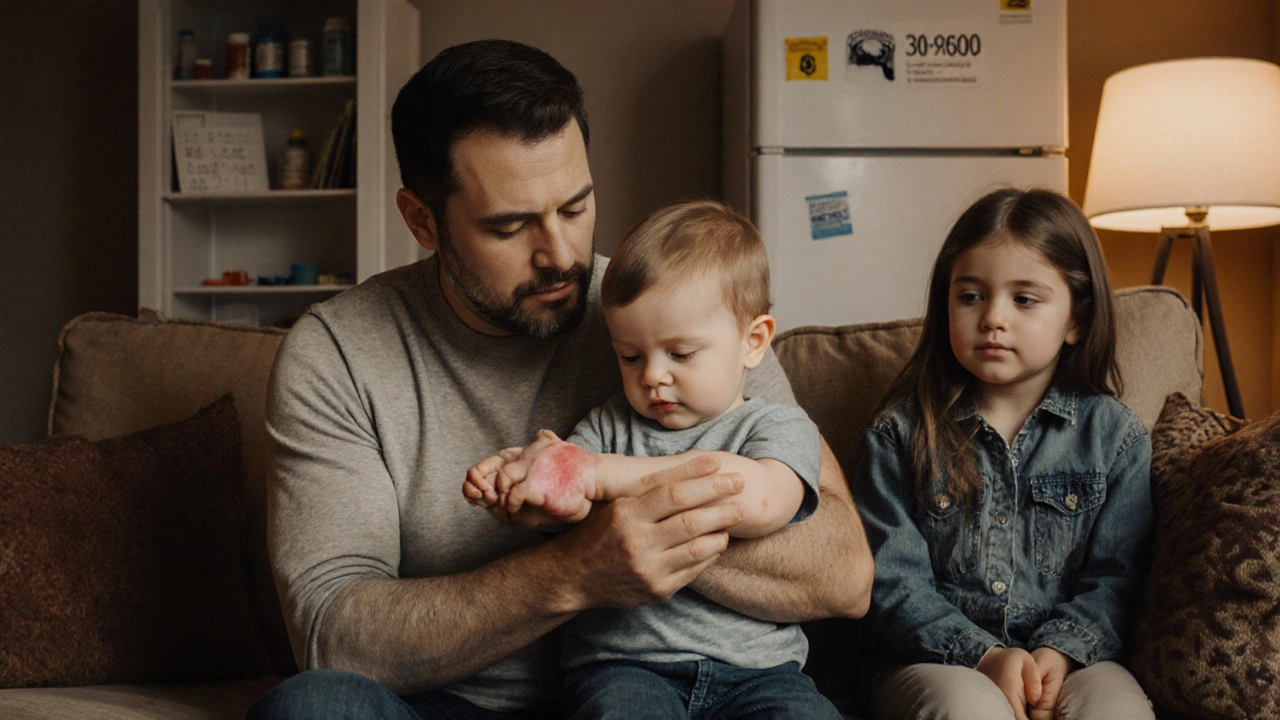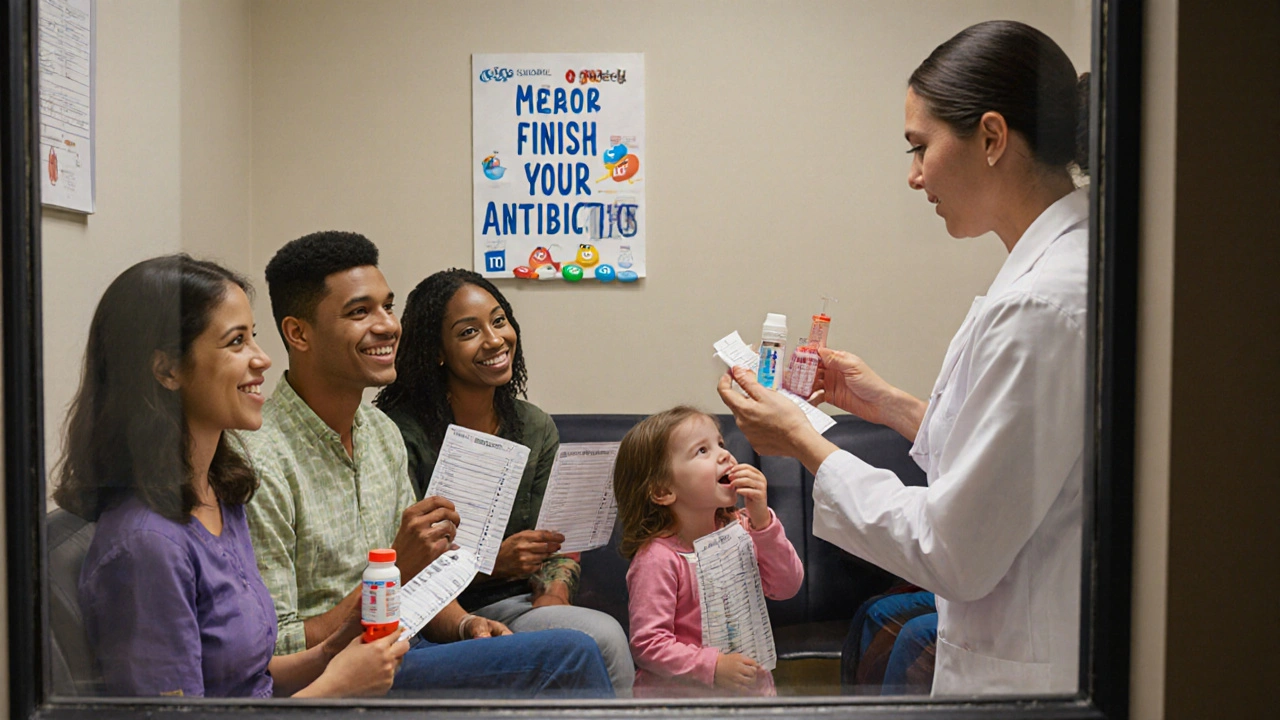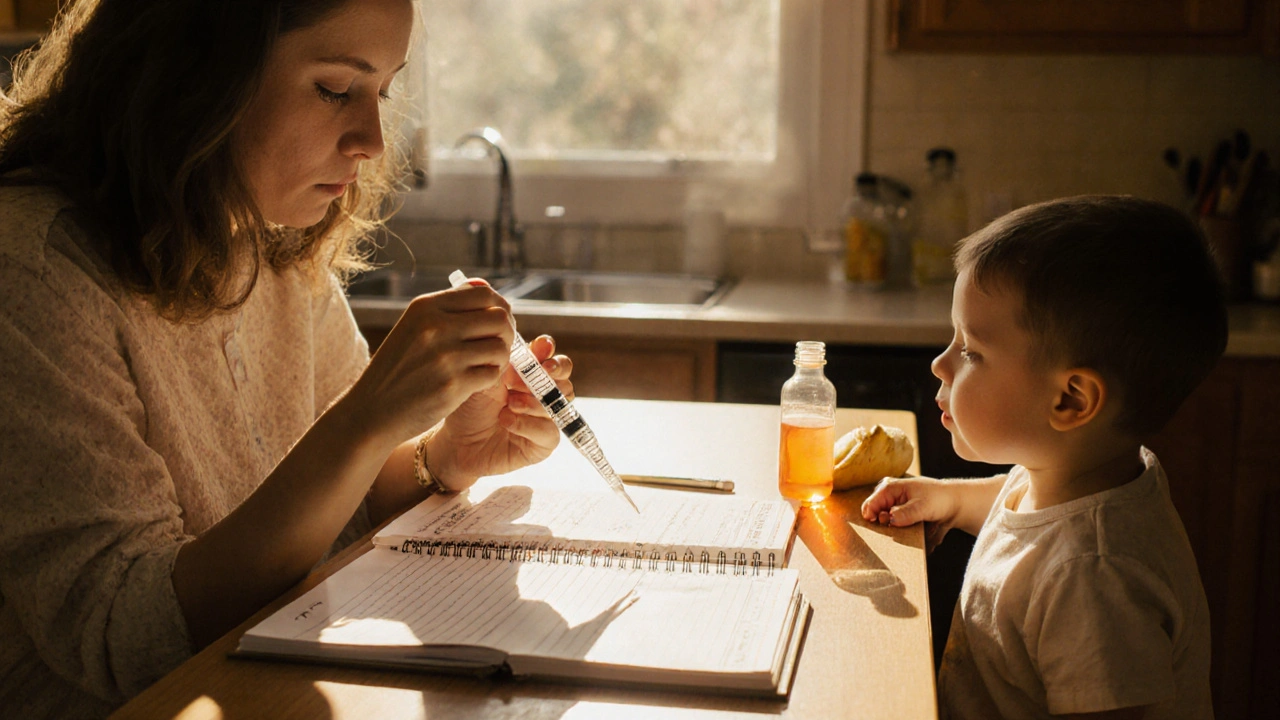When your child starts a new medication, you’re not just giving them a pill or a liquid-you’re stepping into a world of unseen risks. Even when the doctor gets everything right, side effects can show up fast and scare the daylights out of you. A rash. Vomiting. Strange energy spikes. Sleepiness that won’t quit. These aren’t rare. In fact, pediatric medication side effects happen about three times more often in kids than in adults, thanks to their developing bodies processing drugs differently. The good news? Most reactions can be handled safely at home-if you know what to look for and what to do next.
Know the Most Common Side Effects
Not every reaction means danger. Some are mild, expected, and pass on their own. Others need immediate action. Here’s what you’re most likely to see, based on data from children’s hospitals across the U.S.:- Gastrointestinal issues: Upset stomach (42% of cases), diarrhea (28%), vomiting (15%). These are common with antibiotics, pain relievers, and even some allergy meds.
- Central nervous system effects: Drowsiness (19%) is typical with antihistamines like diphenhydramine. But here’s the twist-some kids get hyperactive instead (12%). Yes, the same medicine that makes one child sleepy can make another run around like a tornado.
- Dermatological reactions: Rashes (23%) are frequent. Most are harmless, but if it’s raised, itchy, or spreading fast, it could be serious.
- Other signs: Loss of appetite, mild fever, or unusual crying patterns can also signal a reaction.
Write these down. Keep a simple log: date, time, medication name, dose, and what happened. You’ll thank yourself when you talk to the doctor later.
When to Call the Doctor Right Away
Not every side effect needs an ER trip-but some do. The American Academy of Pediatrics says contact your pediatrician immediately if your child shows:- More than three episodes of vomiting in 24 hours
- Fever above 102°F (38.9°C) that doesn’t come down with acetaminophen or ibuprofen
- Difficulty breathing-faster than 40 breaths per minute in infants, or 30+ in older kids
- Swelling of the face, lips, or tongue
- Hives covering more than 10% of the body
- Unresponsiveness or extreme lethargy
If you’re unsure, call poison control: 1-800-222-1222. It’s free, available 24/7, and staffed by nurses trained in pediatric drug reactions. Don’t wait. Don’t Google. Just call.
Handling Gastrointestinal Side Effects at Home
Stomach upset and diarrhea are the most common complaints. The goal? Prevent dehydration and keep your child comfortable.For vomiting:
- Wait 30 to 60 minutes after the last episode.
- Start with tiny sips-5 to 10 mL (about a teaspoon) of oral rehydration solution like Pedialyte every 5 minutes.
- If they keep it down for an hour, slowly increase the amount.
- Once they’re holding fluids for 4 hours, offer bland foods: bananas, rice, applesauce, toast (the BRAT diet).
- Avoid juice, milk, or sugary drinks-they can make diarrhea worse.
For diarrhea:
- Keep offering fluids-water, broth, or rehydration solutions.
- Continue regular feeding if they’re eating. Starving a child with diarrhea doesn’t help.
- Use diaper rash cream with zinc oxide. Diarrhea can burn skin fast.
- Watch for signs of dehydration: dry mouth, no tears when crying, fewer wet diapers (under 3 in 24 hours for infants).
Dealing with Allergic Reactions
A rash might be nothing. Or it might be the start of anaphylaxis. Here’s how to tell the difference:- Mild: Flat, pink spots, localized, not itchy. Usually goes away in a day or two. Monitor, don’t panic.
- Severe: Raised, itchy hives that spread quickly, swelling around the eyes or lips, wheezing, or trouble swallowing. This is an emergency.
If your child has a known severe allergy and carries an epinephrine auto-injector (like an EpiPen), use it immediately. Then call 911. Don’t wait to see if it gets better. Epinephrine saves lives-and it works fast.
Even if you’re not sure, if your child has trouble breathing or their face swells, call 911. Don’t drive them yourself unless there’s no other option. Emergency crews can start treatment on the way.

Stop the Medication? Not So Fast
It’s tempting. Your child feels awful. You think, “This medicine is making them sick-I’ll stop it.” But that’s often the worst thing you can do.Antibiotics are the biggest offender here. Children’s Healthcare of Atlanta found that 29% of bacterial infections come back because parents stopped antibiotics early-sometimes after just a few days-because the child seemed better. But the bacteria that survived? They become stronger. And next time, the same medicine won’t work.
Always finish the full course unless your doctor tells you to stop. If side effects are severe, call your doctor. Don’t guess. Don’t assume. Ask.
Dosing Errors Are the #1 Problem
Here’s the scary truth: 68% of home medication errors involve wrong dosing. And the most common mistake? Confusing teaspoons and tablespoons.One teaspoon = 5 mL. One tablespoon = 15 mL. That’s a 300% overdose if you use the wrong spoon. And no, the spoon from your kitchen drawer isn’t accurate. Ever.
Use only what comes with the medicine:
- Oral syringes with 0.1 mL markings (best for babies and toddlers)
- Dosing cups with dual metric and imperial lines (FDA-mandated since 2022)
- Never use kitchen spoons, shot glasses, or eyeballing
Pro tip: Take a photo of the medicine label before giving the dose. It helps you double-check the name, dose, and frequency. Studies show this cuts wrong-medication errors by 44%.
Storage Matters More Than You Think
Kids are curious. And they’re fast. If your meds are on the counter, under the sink, or in a purse-they’re not safe.Dr. Helen Arbogast’s research shows locking medications away at least 5 feet high reduces accidental ingestions by 65%. That’s not a suggestion. It’s a rule.
Follow these three steps:
- Keep all meds in their original child-resistant containers. Never transfer them to pill organizers, candy jars, or unmarked bottles.
- Store in a locked cabinet-not just a high shelf. Toddlers can climb.
- Check temperature. Most liquid meds need to be stored between 68-77°F (20-25°C). Some require refrigeration. Read the label. If you’re unsure, call the pharmacy.
And never, ever leave meds in the car. Heat destroys medicine. Cold can freeze it. Both make it useless-or dangerous.

Help Your Child Take the Medicine
If your child refuses pills or spits out liquid, you’re not alone. Nationwide Children’s Hospital found that 89% of kids aged 8-12 learn to swallow pills using a simple trick: practice with candy.Start with tiny candies like Nerds. Then move to Mini M&Ms. Then regular M&Ms. Do one a day for two weeks. Most kids get it. No pressure. No fights. Just practice.
For liquids:
- Use a syringe and squirt slowly along the inside of the cheek-not straight back.
- Chill the medicine if allowed (some taste better cold).
- Follow with a favorite drink (unless the med says “take on empty stomach”).
What’s New in Pediatric Medication Safety?
The field is changing fast. In 2023, apps like MedTrak Pediatric started using barcode scanning to verify doses-cutting errors by 68% in trials. The American Academy of Pediatrics now recommends photographing labels before giving meds. And by 2027, the FDA plans to require all medications to have child-specific dosing instructions and side effect info-something only 62% have today.There’s also emerging research into genetic testing that could predict which kids are at higher risk for bad reactions. It’s not available yet, but it’s coming. For now, your best tools are awareness, careful dosing, and knowing when to call for help.
Final Reminder: You’re Not Alone
Managing side effects at home isn’t about being perfect. It’s about being prepared. You’re doing the right thing by learning this stuff. Keep your log. Know the emergency signs. Use the right tools. And when in doubt-call your pediatrician or poison control.Most side effects are manageable. But the ones that aren’t? They move fast. Being ready can mean the difference between a quiet night at home and a midnight ER visit.
What should I do if my child vomits after taking medication?
Wait 30 to 60 minutes, then start giving small sips of oral rehydration solution-5 to 10 mL every 5 minutes. If they keep it down for an hour, slowly increase the amount. Don’t give more of the same medicine unless the doctor says to. If vomiting continues for more than 24 hours or they show signs of dehydration, call your pediatrician.
Can I give my child over-the-counter medicine to help with side effects?
Only if your doctor says so. Many OTC meds interact with prescription drugs. For example, giving ibuprofen with an antibiotic can increase stomach upset. Even acetaminophen can be risky if your child is already on a med that affects the liver. Always check with your pediatrician before adding anything new.
How do I know if a rash is serious?
A mild rash is flat, pink, and stays in one spot. A serious one is raised, itchy, spreads quickly, or is accompanied by swelling, trouble breathing, or fever. If hives cover more than 10% of the body or your child has facial swelling, use an epinephrine auto-injector if prescribed and call 911 immediately.
Is it okay to stop antibiotics if my child feels better?
No. Stopping antibiotics early is one of the most common mistakes parents make. Even if your child seems fine, bacteria may still be alive. This can cause the infection to return-and the remaining bacteria may become resistant to the drug. Always finish the full course unless your doctor tells you otherwise.
What’s the safest way to measure liquid medication?
Use the oral syringe or dosing cup that came with the medicine. Never use kitchen spoons-they’re not accurate. Look for syringes with 0.1 mL markings. If the medicine comes with a cup, make sure it has both milliliter (mL) and teaspoon (tsp) markings. Always double-check the dose against the prescription label.
Where should I store my child’s medications?
In a locked cabinet, at least 5 feet off the ground, and out of reach of children. Keep them in their original child-resistant containers. Never transfer them to pill organizers, candy jars, or unmarked bottles. Store most liquid meds at room temperature (68-77°F), unless the label says to refrigerate. Avoid storing in bathrooms or cars-heat and moisture ruin medicine.
My child is hyperactive after taking allergy medicine-is that normal?
Yes, it’s more common in kids than adults. Diphenhydramine (Benadryl) can cause paradoxical hyperactivity in about 15% of children. Document the behavior-how long it lasted, what they did, whether they seemed agitated or exhausted afterward. Share this with your doctor. They may switch to a different antihistamine like cetirizine or loratadine, which are less likely to cause this reaction.
Can I use a pill splitter for my child’s tablet?
Only if your pharmacist or doctor says it’s safe. Some tablets are coated or designed to release medicine slowly. Splitting them can change how the drug works or make it unsafe. Always ask before splitting. For younger kids, ask if the medicine comes in liquid form or if a different strength is available.

Daisy L
November 22, 2025 AT 05:58Okay, but let’s be real-why does the FDA wait until 2027 to mandate child-specific dosing instructions? We’ve been begging for this since 2015. Meanwhile, my kid got a 300% overdose because the pharmacy gave me a cup with no mL markings. And no, I didn’t use a kitchen spoon-I used the one that came with the medicine, but it was labeled ‘1 tsp = 5 mL’ and the script said 15 mL. Who’s responsible here? The doctor? The pharmacist? The system? I’m done trusting anyone who doesn’t have a kid who’s been poisoned by a typo.
Anne Nylander
November 22, 2025 AT 08:24Yessss!! I used the syringe and it saved my life (and my sanity). My 3yo used to spit out everything. Now we do it like a game-‘squirty snake time!’ and they love it. Also, pics of the label? Genius. I started doing that after I almost gave Tylenol instead of amoxicillin. I still get nervous but now I’m prepared. You got this, mama/papa!
Franck Emma
November 23, 2025 AT 09:16My daughter went into anaphylaxis on Benadryl. Not once. Twice. And the ER nurse said, ‘Oh, that’s rare.’ RARE? It happened in front of me. She turned blue. I screamed. Nobody listened until the pulse dropped. Don’t wait. Don’t Google. Don’t hope. Just call 911. Always.
Eliza Oakes
November 24, 2025 AT 21:24Let me stop you right there. This whole article is corporate fluff wrapped in pediatric panic. ‘Use the dosing cup’? Sure. But did you mention that the FDA-mandated cups are often inaccurate? I tested five of them-two were off by 20%. And ‘lock meds away’? That’s cute. My kid’s 18 months. He climbs like a monkey and opens locks with his teeth. Also, ‘finish antibiotics’? I’ve seen kids get C. diff from overprescribing. You’re not a doctor. Stop telling parents what to do. Ask yourself: who profits from this fear?
Florian Moser
November 24, 2025 AT 21:57This is one of the clearest, most practical guides I’ve ever read on pediatric meds. Seriously-thank you. The BRAT diet tip, the syringe advice, the photo trick? All gold. I’ve been a nurse for 12 years and even I learned something. Keep sharing this kind of stuff. It saves lives. And for the record, the 68% dosing error stat? That’s real. I’ve seen it in the ER. You’re not overreacting. You’re being smart.
jim cerqua
November 25, 2025 AT 04:24They want you to think this is about safety. But it’s not. It’s about control. Who decides what’s ‘mild’ vs ‘severe’? The FDA? The pharmaceutical lobby? The same people who made Vioxx and pushed opioids? You’re being trained to panic over a rash while ignoring the real problem: overmedication. My kid had a fever for 3 days. We did nothing. He got better. No drugs. No ER. Just rest. Why is that not an option here?
Donald Frantz
November 25, 2025 AT 08:02Has anyone verified the 29% antibiotic recurrence stat? I checked the Children’s Healthcare of Atlanta website-no such study. And the 68% dosing error? That’s from a 2019 Pediatrics paper, but it included caregivers using kitchen spoons. Of course it’s high. That’s not a systemic failure-that’s parental ignorance. The real issue is education, not regulation. Also, why is ‘EpiPen’ capitalized but ‘pedialyte’ isn’t? Minor, but tells you something about the source.
Sammy Williams
November 25, 2025 AT 22:27Just wanted to say I’ve been using the candy method for my 9yo and it worked like magic. Started with Nerds, then M&Ms, now they swallow whole pills like a pro. Also, chilling the medicine? Huge difference with amoxicillin. And the photo trick? I do it every time. Even if I’m tired. Even if I’m mad. Always. It’s saved me twice. You’re not alone in this. We’re all just trying not to mess up.
Julia Strothers
November 26, 2025 AT 16:03They’re lying. All of it. The ‘pediatric side effects happen 3x more often’? That’s a scare tactic to sell more monitoring apps and child-resistant packaging. My kid got a rash after antibiotics. It went away. No ER. No poison control. No panic. But now you’re told to treat every rash like a bioweapon. Who benefits? The hospitals. The drug companies. The app developers. You’re being manipulated into fear. And the ‘locked cabinet’? That’s not safety-that’s surveillance. You think your kid won’t find it? They’ll find it. And then you’ll be the villain for ‘locking them out of their own medicine.’
Erika Sta. Maria
November 28, 2025 AT 07:52Ohhh this is so American. You think meds are the answer to everything. In India, we use turmeric, honey, neem, and patience. My cousin’s son had fever for 5 days-no meds. Just rest, fluids, and prayer. He’s fine. Why do you need a syringe? Why do you need a photo? Why do you need an app? Maybe your child is not sick. Maybe you are. Maybe you need to stop medicating everything and just… be with your kid. That’s healing.